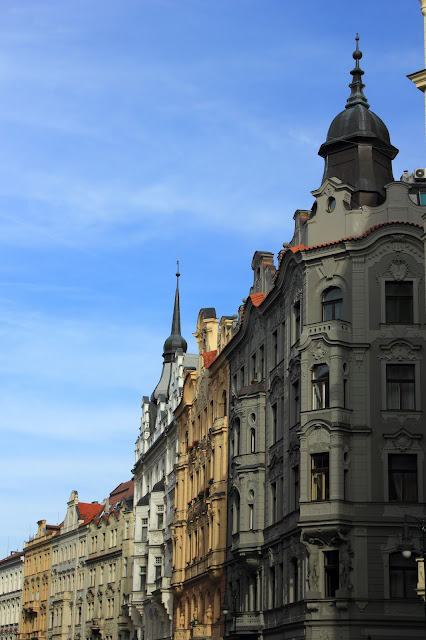Today’s Czech Republic was once part of The Kingdom of
Bohemia, under the Holy Roman Empire which included eastern European countries as Austria, Poland ,
Hungary, (then) Yugoslavia, etc and Prague was it’s capital . From the early 16th
century, the kingdom was ruled by the very powerful Austrian Habsburg Empire.
The Habsburgs expanded their territory throughout Europe and
their monarchy continued for nearly 400 years over Bohemia. After the decline of Habsburg Empire at the end
of World war I, “Czechoslovakia” was formed.
With the beginning of World War II, Czechoslovakia was annexed by the Nazis. Initially they were to occupy only the German speaking territories but eventually entire Czechoslovakia fell into their control.
German Occupied Czechoslovakia was freed with the support of the Allies in 1945. Thereafter, the country became a communist state under
Soviet influence. Years of
growing dissatisfaction amongst people gave birth to several uprisings and
movements. One very important and significant event was the Velvet Revolution
which was a non-violent transition of power in 1989 which took place for a
month and officially ended 41 years of Communist rule in the country.
And finally the dissolution of Czechoslovakia was peacefully
achieved in 1991 and thus was formed Czech Republic and Slovakia.
The above is only a miniscule of a fraction of 1500 years of
History.
Today’s Prague is one of the most beautiful cities and sought after destinations in Europe, buzzing with thousands of visitors from all over the world. Prague’s Historical centre is enlisted under UNESCO World Heritage Centre and is dotted with historical monuments and structures. It is one of the best preserved cities in the world and the best way to explore Prague is by taking long walks and getting lost in the cobbled streets. Every structure is blended with art, beautiful lanterns on streets, flower beds and decorations in cafes and windows, the very quiet Vltava river banks, beautiful parks- so much history , so medieval!
For a long while , I wanted to see it for myself - Prague's skyline and walk through it's famed cobbled stone streets..but with just 6 nights in Prague out of my 10 full days trip, I may have barely scratched the surface. My original itinerary was to cover only Czech Republic, but was also too smitten by Vienna (just 4.5 hours away), so plugged in a 3 nights trip in between, which allowed me to catch a whiff of the city and I had to had to visit Cesky Krumlov , so another day was devoted to CK .
To get the best views of Prague, you need to take some effort . So, climbed the towers ,which are anything between 170-200+ steps , steep,narrow spiral staircase up the tower! On few days I was'nt very fortunate with the weather/ light but nonetheless, the views were still worth every step. Some of them have an old elevator which in itself is another experience .
View from Old Clock Tower - 172 feet high above ..

Today’s Prague is one of the most beautiful cities and sought after destinations in Europe, buzzing with thousands of visitors from all over the world. Prague’s Historical centre is enlisted under UNESCO World Heritage Centre and is dotted with historical monuments and structures. It is one of the best preserved cities in the world and the best way to explore Prague is by taking long walks and getting lost in the cobbled streets. Every structure is blended with art, beautiful lanterns on streets, flower beds and decorations in cafes and windows, the very quiet Vltava river banks, beautiful parks- so much history , so medieval!
For a long while , I wanted to see it for myself - Prague's skyline and walk through it's famed cobbled stone streets..but with just 6 nights in Prague out of my 10 full days trip, I may have barely scratched the surface. My original itinerary was to cover only Czech Republic, but was also too smitten by Vienna (just 4.5 hours away), so plugged in a 3 nights trip in between, which allowed me to catch a whiff of the city and I had to had to visit Cesky Krumlov , so another day was devoted to CK .
To get the best views of Prague, you need to take some effort . So, climbed the towers ,which are anything between 170-200+ steps , steep,narrow spiral staircase up the tower! On few days I was'nt very fortunate with the weather/ light but nonetheless, the views were still worth every step. Some of them have an old elevator which in itself is another experience .
View from Old Clock Tower - 172 feet high above ..
 |
| Old Town Square |

Most of Prague's Historical Centre was built between 11th - 18th century and displays an ensemble of interesting works of art and architectural splendour .
The next view is from Charles Bridge Tower ..and a similar climb but another day !
 |
| Charles bridge is the most famous bridge over Vltava and also the most crowded. |
 |
| One End of Charles Bridge with St.Nicholas Church in the background . |
St.Nicholas Church is a very beautiful Baroque church built in the 17th century. Beautiful frescos fill the church walls and Dome ceiling .The interiors are decorated with sculptures bearing the colors in gold,white and pastels .
 |
| The very ornate interiors of St.Nicholas Church |
Walking through The city of hundred Spires, you are confronted endlessly by art.. Pastel colored buildings with incredible Art works dots the city .
 |
| A trip to Prague is incomplete without a boat cruise on the Vltava . |















